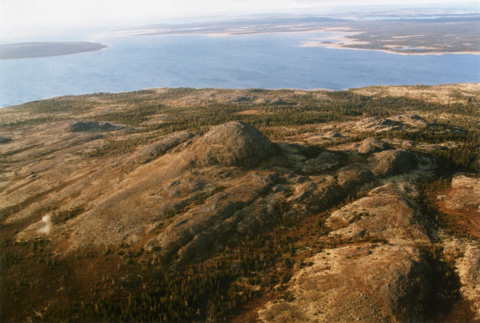Meshikamau-shipu Travel Route National Historic Event

© Petshishkapushkau. Michael Weiler.
The Meshikamau-shipu Travel Route in Labrador is approximately 330 kilometres and follows a series of rivers and lakes between Sheshatshiu on Lake Melville/Atatshi-uinipeku and the Meshikamau area, which is the location of the former Lake Michikamau and today is part of the Smallwood Reservoir. Meshikamau-shipu is the Innu-aimun place name for “river to Meshikamau” and the Travel Route represents Innu land use and occupancy of the Labrador peninsula through active and ancestral camp sites, with some dating back 3,500 years, as well as portage trails, birth and burial locations, and evidence of Innu involvement in the fur trade. It embodies the centrality and rhythm of travel across the land, a hallmark of the Innu traditional migratory lifestyle, and expresses economic, cultural, and spiritual aspects of Innu life.
Journeying along the route brought Innu to familiar places of cultural significance such as gathering sites where Innu families from across Nitassinan, the Innu homeland, came together. It brought Innu to places that continue to be tied to legends and have spiritual significance. The route symbolizes continuity and cultural resilience in confronting the challenges to the Innu way of life since the beginnings of European settlement. A close relationship with the physical geography of Nitassinan is further represented in long-held Innu place names along the route.
Until the time of permanent settlement in the 1960s, the Innu way of life was based on mobility. Seasonal and regional moves encompassed hunting and gathering of resources for food and materials at specific times and places, and importantly, included gatherings with other Innu families. The Meshikamau-shipu Travel Route embodies the foundational elements of this way of life, including the maintenance of human connections, harvesting resources, and walking, paddling, or boating across the deeply revered landscape of Nitassinan.
Families continue to leave Sheshatshiu to spend periods of time at interior camps along the route as often as possible. It continues to have abiding cultural importance despite the impacts of decreased country travel, the flooding of the Meshikamau area, and a range of other complex effects of colonisation.
Archaeological research has found stone tools and habitation features, providing evidence that the travel route bears witness to millennia of human use by Ancestral Innu and much earlier hunter-gatherer peoples. Some of the tools and flaking debris are made of stone types from distant sources, indicating long-distance travel and exchange. Innu oral histories tell of occupations that may well predate what is known from archaeological research. More recent Innu presence along the route is represented in historic camps, but also in oral histories and in a range of early documents that describe Innu economic activities and relations with early missionaries, traders, and explorers.
The National Program of Historical Commemoration relies on the participation of Canadians in the identification of places, events and persons of national historic significance. Any member of the public can nominate a topic for consideration by the Historic Sites and Monuments Board of Canada.
- Date modified :